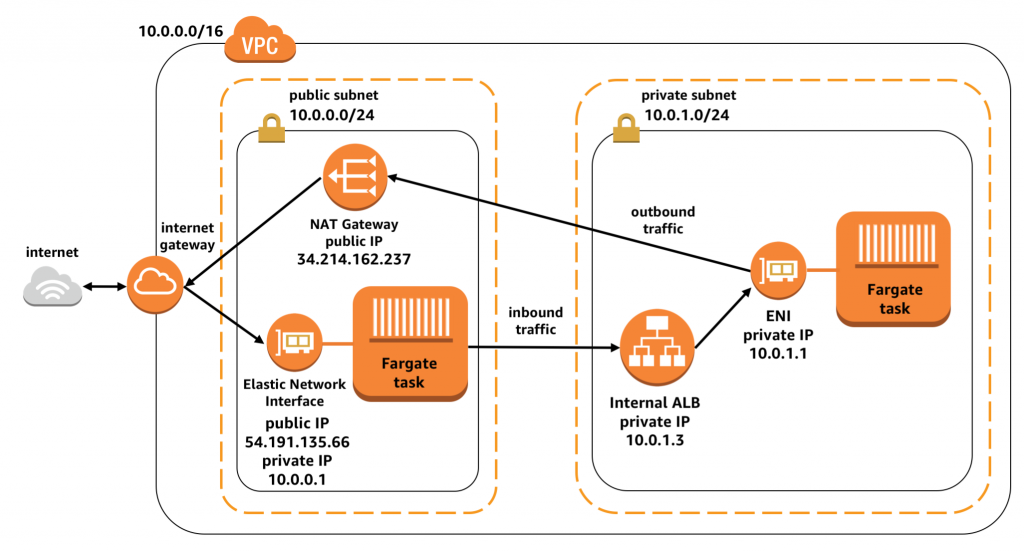AWS Compute Blog
Tag: Docker
Maintaining Transport Layer Security all the way to your container part 2: Using AWS Certificate Manager Private Certificate Authority
This post contributed by AWS Senior Cloud Infrastructure Architect Anabell St Vincent and AWS Solutions Architect Alex Kimber. The previous post, Maintaining Transport Layer Security All the Way to Your Container, covered how the layer 4 Network Load Balancer can be used to maintain Transport Layer Security (TLS) all the way from the client to […]
Task Networking in AWS Fargate
AWS Fargate is a new compute engine for containers that allows you to focus on running your application without needing to provision, monitor, or manage the underlying compute infrastructure. You package your application into a Docker container that you can then launch using your container orchestration tool of choice. Fargate allows you to use containers […]
Building Blocks of Amazon ECS
So, what’s Amazon Elastic Container Service (ECS)? ECS is a managed service for running containers on AWS, designed to make it easy to run applications in the cloud without worrying about configuring the environment for your code to run in. Using ECS, you can easily deploy containers to host a simple website or run complex […]
Running Windows Containers on Amazon ECS
This post was developed and written by Jeremy Cowan, Thomas Fuller, Samuel Karp, and Akram Chetibi. — Containers have revolutionized the way that developers build, package, deploy, and run applications. Initially, containers only supported code and tooling for Linux applications. With the release of Docker Engine for Windows Server 2016, Windows developers have started to […]
The re:Invent 2017 Containers After-party Guide
Feeling uncontainable? re:Invent 2017 might be over, but the containers party doesn’t have to stop. Here are some ways you can keep learning about containers on AWS. Learn about containers in Austin and New York Come join AWS this week at KubeCon in Austin, Texas! We’ll be sharing best practices for running Kubernetes on AWS […]
Capturing Custom, High-Resolution Metrics from Containers Using AWS Step Functions and AWS Lambda
Contributed by Trevor Sullivan, AWS Solutions Architect When you deploy containers with Amazon ECS, are you gathering all of the key metrics so that you can correctly monitor the overall health of your ECS cluster? By default, ECS writes metrics to Amazon CloudWatch in 5-minute increments. For complex or large services, this may not be sufficient to make […]
Introducing Cloud Native Networking for Amazon ECS Containers
This post courtesy of ECS Sr. Software Dev Engineer Anirudh Aithal. Today, AWS announced task networking for Amazon ECS. This feature brings Amazon EC2 networking capabilities to tasks using elastic network interfaces. An elastic network interface is a virtual network interface that you can attach to an instance in a VPC. When you launch an […]
Under the Hood: Task Networking for Amazon ECS
This post courtesy of ECS Sr. Software Dev Engineer Anirudh Aithal. Today, AWS announced task networking for Amazon ECS, which enables elastic network interfaces to be attached to containers. In this post, I take a closer look at how this new container-native “awsvpc” network mode is implemented using container networking interface plugins on ECS managed instances (referred […]
Clean up Your Container Images with Amazon ECR Lifecycle Policies
This post comes from the desk of Brent Langston. — Starting today, customers can keep their container image repositories tidy by automatically removing old or unused images using lifecycle policies, now available as part of Amazon EC2 Container Registry (Amazon ECR). Amazon ECR is a fully managed Docker container registry that makes it easy to […]
Manage Kubernetes Clusters on AWS Using Kops
Any containerized application typically consists of multiple containers. There are containers for the application itself, a database, possibly a web server, and so on. During development, it’s normal to build and test this multi-container application on a single host. This approach works fine during early dev and test cycles but becomes a single point of […]







